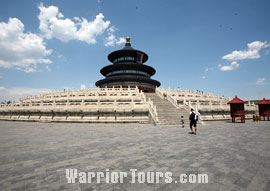- Beihai Park
- Forbidden City
- Great Wall
- Hutongs and Courtyards
- Ming Tombs & Sacred Way
- Summer Palace
- Temple of Heaven & Yonghe Lamasery
- Tiananmen Square & Grand View Garden
Temple of Heaven & Yonghe Lamasery
![]() Temple of Heaven
Temple of Heaven
Located in the southwestern part of Chongwen District in the city area, Temple of Heaven is the largest temple architecture in China with a history of over 500 years.
In ancient China, emperors considered themselves as 'The Son of Heaven', inheriting supreme power to dominate the world. Originally built in the Ming Dynasty (1368 - 1644) in 1420, the Temple of Heaven was the sacrificial place for emperors to hold prayer and sacrificial ceremonies.
With an area of about 2,700 square kilometers (667,185 acres), the Temple of Heaven is much bigger than Forbidden City and a little smaller than Summer Palace. It is enclosed by a long wall. The northern part is semicircular symbolizing Heaven and the southern part is square symbolizing Earth. This design reflects ancient Chinese thought of 'The heaven is round and the earth is square'. Main constructions include Hall of Prayer for Good Harvest (Qi Nian Dian), Circular Mound Altar (Yuan Qiu Tan), Imperial Vault of Heaven (Huang Qiong Yu) and other associated buildings. A long bridge called Vermilion Steps Bridge (Dan Bi Qiao) runs along the north-south axis connecting most of the main buildings.
Nowadays, the site is a park (Tiantan Gongyuan) and is a popular leisure destination for local people. Elderly Beijing people like to begin their day life with morning exercises in the park. The park is open from 6:00 to 20:00 while the Hall of Prayer for Good Harvest closes around 17:00.
| Admission Fee: | CNY 30 (Nov. 1 to Mar. 31) CNY 35 (Apr. 1 to Oct. 31) |
| Opening Hours: | 06:00 to 20:00 |
| Recommended Time for a Visit: |
One and a half hour |
| Bus Route: | 34,6,35 |

Located at the northeastern corner of Beijing City, Yonghe Lamasery, originally built in 1694 in China's Qing Dynasty (1644 - 1911) is reputed to be the largest Tibetan Buddhist temple in the city.
The original construction was the mansion of the third Qing emperor, Yongzheng before he inherited the throne in 1723. In 1725, half of the mansion was extended into an imperial palace for the emperor and the remaining part was awarded to Panchen Lama, the yellow sect of Tibetan Buddhism, as a temple. In 1774, the building was largely reconstructed under the order of Emperor Qianlong and resulted in the present temple complex.

The temple complex has a typical Chinese Buddhist temple layout of three courtyard structures. The main buildings are arranged on a north-south axis including Hall of the Heavenly Kings, Hall of Harmony and Peace (Yong He Gong), Hall of the Wheel of the Law (Fa Lun Dian) and Pavilion of Ten Thousand Happiness (Wan Fu Ge). A variety of associated buildings on each side of the axis house study rooms and monks' dormitories.
The whole architecture features a blending of Han, Manchu, Mongolian and Tibetan Buddhist styles and over the entrance gate of each main hall hangs a plaque with the name of the hall with inscriptions in Tibetan, Mongolian and Chinese languages.
A collection of various Buddha and Arhat statues are enshrined in the temple and among them an 18-meter-high (60 feet) Buddha statue carved out of sandalwood is very precious.
| Admission Fee: | CNY 25 |
| Opening Hours: | 09:00 to 16:00 |
| Recommended Time for a Visit: |
One hour |
| Bus Route: | 13, 18, 44, 62, 116, 407, 807 |

